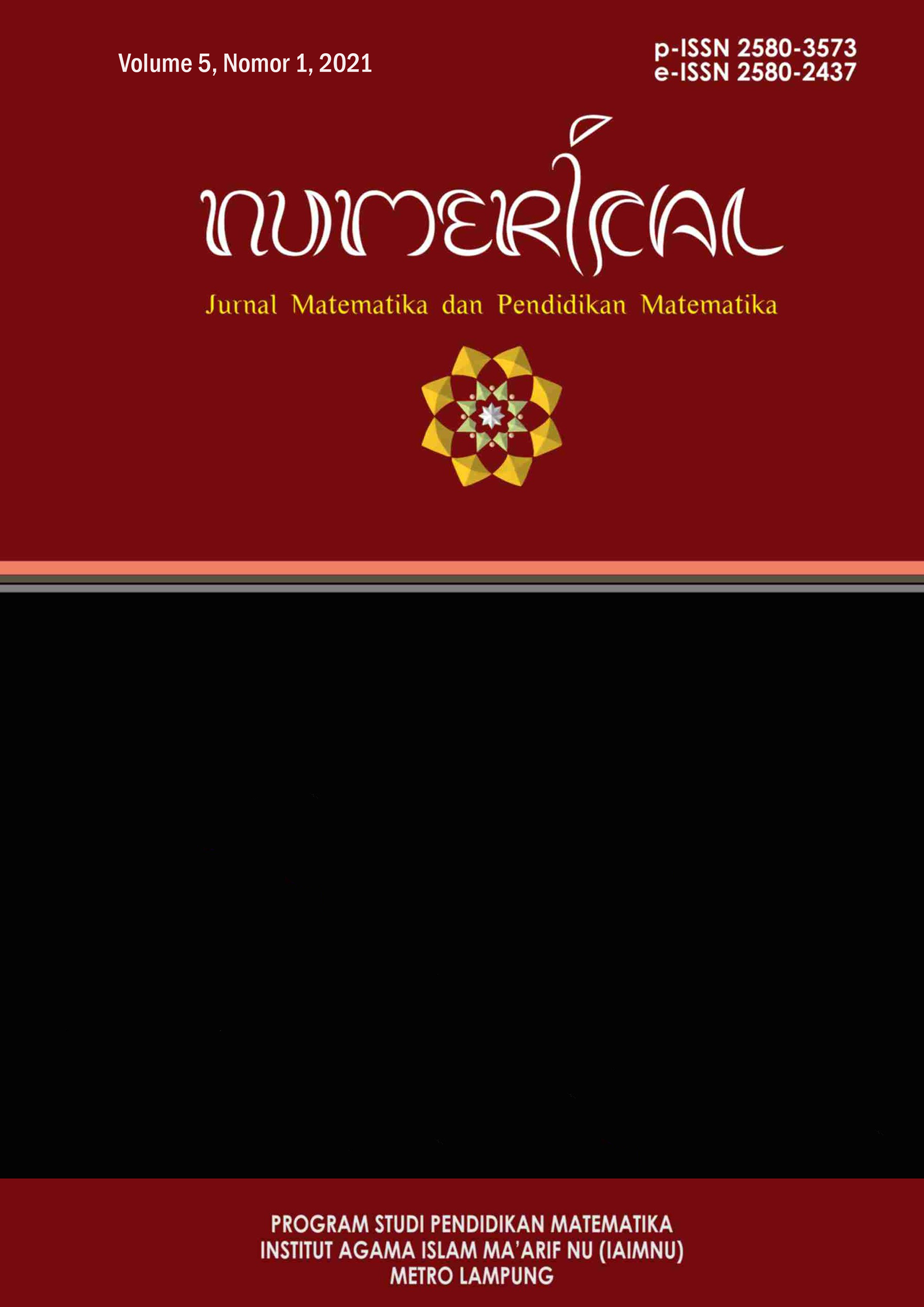Qurmatica-Based Learning as a Solution to Reduce Anxiety for Students' Mathematics Phobias
DOI:
https://doi.org/10.25217/numerical.v5i1.1355Keywords:
Mathematics Anxiety, Mathematics Learning, Qurmatica-Based LearningAbstract
Mathematics anxiety is an obstacle for students in carrying out mathematics learning, especially there are still students who think mathematics is a difficult and boring subject. The ability to understand mathematical concepts of each student is different. There are several influencing factors, one of which is the anxiety experienced by students when learning mathematics. Therefore, mathematics is one of the important lessons to be learned, not only students at school but also students who are studying in Islamic boarding schools. Some of the knowledge that students learn in Islamic boarding schools also requires mathematics. For example, when studying the science of zakat distribution, Faraid science, and the like. The students have applied the linkage of mathematical concepts with Islamic concepts studied by students in Islamic boarding schools. In this study, the data collection method used was a literature study. This method was used to obtain additional literature data from reference books regarding mathematics anxiety towards students. In fact, mathematics is a basic science that is important for the advancement of science and technology, and the concepts in learning mathematics are used in everyday life. The author tries to offer a solution to reduce the level of anxiety of students towards mathematics by conducting learning that integrates the Qur'an with mathematics using the QURMATICA method as a solution can be used to play and learn mathematics and to encourage students' enthusiasm in learning mathematics and students can reduce their mathematics anxiety.
References
H. Sukoco and I. Suharjo, “Mathematics Self-Efficacy Scale Based on Computer,” Indonesian Journal of Mathematics Education, vol. 2, no. 1, Art. no. 1, Apr. 2019, doi: 10.31002/ijome.v2i1.1248.
S. H. J., Mengobarkan Api Matematika. Sukabumi: CV Jejak, 2017.
M. S. Anwar, C. Choirudin, E. F. Ningsih, T. Dewi, and A. Maseleno, “Developing an Interactive Mathematics Multimedia Learning Based on Ispring Presenter in Increasing Students’ Interest in Learning Mathematics,” Al-Jabar: Jurnal Pendidikan Matematika, vol. 10, no. 1, Art. no. 1, Jul. 2019, doi: 10.24042/ajpm.v10i1.4445.
F. Fatqurhohman, “Pemahaman Konsep Matematika Siswa Dalam Menyelesaikan Masalah Bangun Datar,” JIPM (Jurnal Ilmiah Pendidikan Matematika), vol. 4, no. 2, Art. no. 2, Mar. 2016, doi: 10.25273/jipm.v4i2.847.
M. Anouti, S. Shehayeb, and M. Mchiek, “The Effect of Math Anxiety on Students’ Performance in the Intermediate and Secondary Classes,” International Journal of Science and Research (IJSR), vol. 8, pp. 739–745, Jan. 2018, doi: 10.21275/ART20201161.
U. Xolocotzin, Understanding Emotions in Mathematical Thinking and Learning. Academic Press, 2017.
H. P. Susanto, “Analisis Hubungan Kecemasan, Aktivitas, dan Motivasi Berprestasi Dengan Hasil Belajar Matematika Siswa,” Beta: Jurnal Tadris Matematika, vol. 9, no. 2, Art. no. 2, Dec. 2016, doi: 10.20414/betajtm.v9i2.10.
T. A. Pulungan, “Deskripsi Kecemasan Belajar Matematika (Mathematics Anxiety) Santriwati Madrasah Aliyah Swasta Pondok Pesantren Al-Ansor Manunggang Julu Kecamatan Padangsidimpuan Tenggara,” skripsi, IAIN Padangsidimpuan, 2018. Accessed: Jun. 29, 2021. [Online]. Available: http://etd.iain-padangsidimpuan.ac.id/2297/
A. H. Fathani, “Pembelajaran Matematika bagi Santri Pondok Pesantren Berbasis Kecerdasan Majemuk,” ANARGYA: Jurnal Ilmiah Pendidikan Matematika, vol. 2, no. 1, Art. no. 1, Apr. 2019, doi: 10.24176/anargya.v2i1.3043.
M. Zed, Metode Penelitian Kepustakaan. Jakarta: Yayasan Pustaka Obor Indonesia, 2014.
M. Suárez-Pellicioni, M. I. Núñez-Peña, and À. Colomé, “Math anxiety: A review of its cognitive consequences, psychophysiological correlates, and brain bases,” Cogn Affect Behav Neurosci, vol. 16, no. 1, pp. 3–22, Feb. 2016, doi: 10.3758/s13415-015-0370-7.
D. Juniati and I. K. Budayasa, “The Mathematics Anxiety: Do Prospective Math Teachers Also Experience It?,” J. Phys.: Conf. Ser., vol. 1663, p. 012032, Oct. 2020, doi: 10.1088/1742-6596/1663/1/012032.
R. Jiang et al., “How Mathematics Anxiety Affects Students’ Inflexible Perseverance In Mathematics Problem‐Solving: Examining The Mediating Role Of Cognitive Reflection,” British Journal of Educational Psychology, vol. 91, Jun. 2020, doi: 10.1111/bjep.12364.
C. Malone and A. Wachholtz, “The Relationship of Anxiety and Depression to Subjective Well-Being in a Mainland Chinese Sample,” J Relig Health, vol. 57, no. 1, pp. 266–278, Feb. 2018, doi: 10.1007/s10943-017-0447-4.
S. I. Hasanah, “Sumber Belajar Matematika Dari Lingkungan Alam Sekitar Berbasis Pondok Pesantren,” INTERAKSI : Jurnal Kependidikan, vol. 9, no. 1, Art. no. 1, Jan. 2014, Accessed: Jun. 29, 2021. [Online]. Available: http://ejournal.unira.ac.id/index.php/jurnal_interaksi/article/view/518
C. Choirudin, E. F. Ningsih, M. S. Anwar, A. Choirunnisa, and A. Maseleno, “The Development of Mathematical Students Worksheet Based on Islamic Values Using Contextual Approach,” International Journal on Emerging Mathematics Education, vol. 3, no. 2, Art. no. 2, Apr. 2020, doi: 10.12928/ijeme.v3i2.13286.
Choirudin, M. S. Anwar, I. N. Azizah, Wawan, and A. Wahyudi, “Pengembangan LKPD Matematika Berbasis Kaligrafi dengan Pendekatan Guided Discovery Learning,” Jurnal Pendidikan Matematika (JPM), vol. 7, no. 1, Art. no. 1, Jan. 2021, doi: 10.33474/jpm.v7i1.6738.
P. Liljedahl, M. Santos-Trigo, U. Malaspina, and R. Bruder, “Problem Solving in Mathematics Education,” in Problem Solving in Mathematics Education, P. Liljedahl, M. Santos-Trigo, U. Malaspina, and R. Bruder, Eds. Cham: Springer International Publishing, 2016, pp. 1–39. doi: 10.1007/978-3-319-40730-2_1.
Syaifuddin, A. H. Fathani, and Surahmat, “Teacher Actions Bring up Students’ Thoughts in Solving Mathematical Problems,” ujer, vol. 7, no. 12, pp. 2784–2788, Dec. 2019, doi: 10.13189/ujer.2019.071228.
S. D. Handayani, “Pengaruh Kecemasan Matematika terhadap Pemahaman Konsep Matematika,” SAP (Susunan Artikel Pendidikan), vol. 4, no. 1, Art. no. 1, Aug. 2019, doi: 10.30998/sap.v4i1.3708.







